Charger Miboxer C4
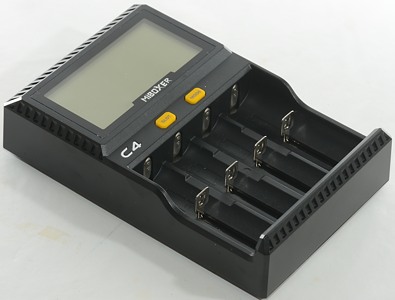
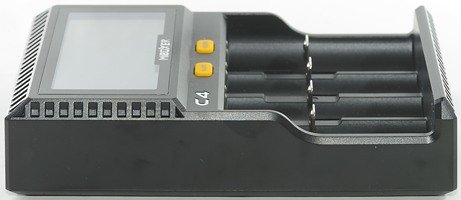
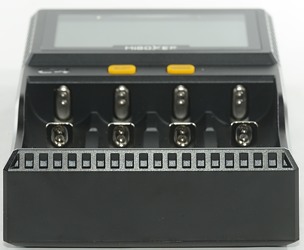
Miboxer is a new brand in chargers, this model is a four slot universal charger with some analyzing capabilities.


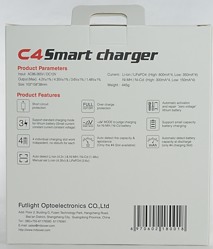

I got the charger in a cardboard box
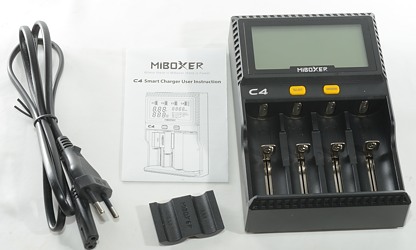
The pack included the charger, a mains cable, a AAA spacer and a instruction sheet.
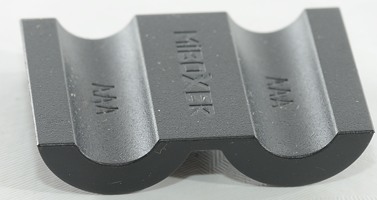
The AAA spacer is not to make the battery longer, but to center the battery better in the slot. The charger can handle AAA cells without it, but they are easier to place when using this spacer.

The charger can both work on mains voltage and 12V.
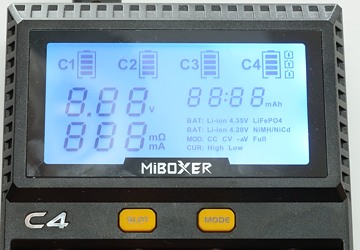
The user interface is a display and two buttons. The display will only show information for one slot at a time, the usual information is voltage, charge current and used time, on slot four it is also possible to show capacity.
The SLOT button is used to select slot.
The MODE button select what to change (Voltage/Current/Test) by short presses (Select item will flash), the actual value is selected by longer presses
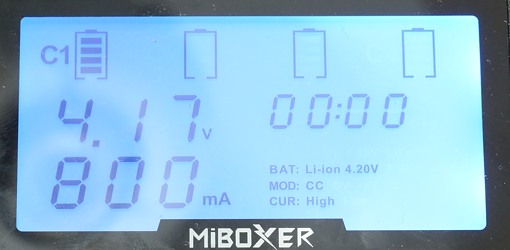
Charging a 4.2V LiIon with high current
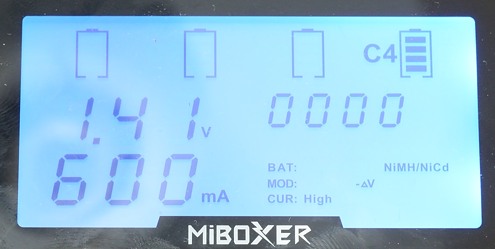
A NiMH in the final phase of charging.
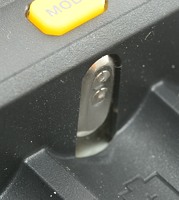

The charger has the usual slider construction. It can handle from 29mm to 69.5mm, this prevents the charger from handling the longest protected 18650 and 26650 batteries.

Here is an AAA cell with the spacer under it.


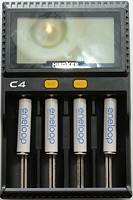
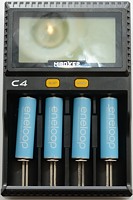
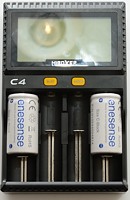
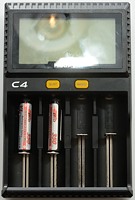
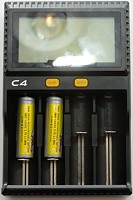
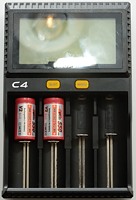
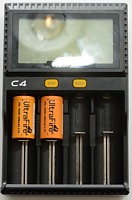
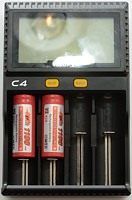

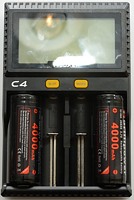
Measurements charger
- Power consumption when idle is 0.2 watt (Background light off).
- Without power it will discharge a LiIon battery with about 2mA
- Without power it will discharge a NiMH battery with about 0.2mA
- A full LiIon battery will be kept at 4.20V with a small charge current (Oops, not good).
- At 0V battery voltage the charger will charge with 300mA.
- Above 1.6V the charger assumes LiIon
- The charger will restart when a battery is inserted or power is cycled.
- The meter is within 0.01V and works from 0V
Charging 4.2V LiIon
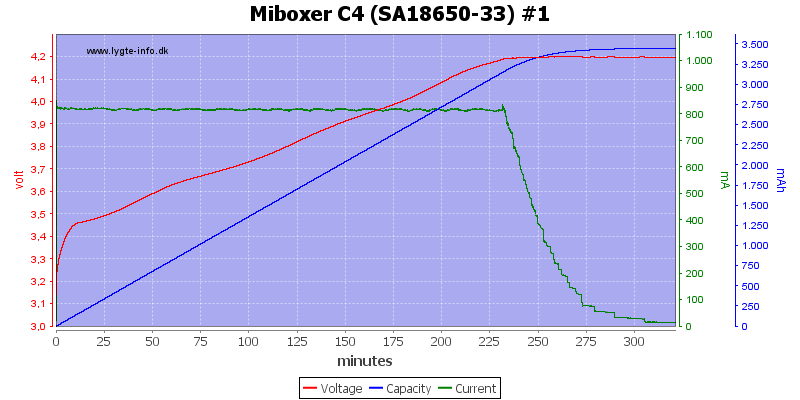
The charge curve is a good CC/CV voltage charge, but there is no termination.
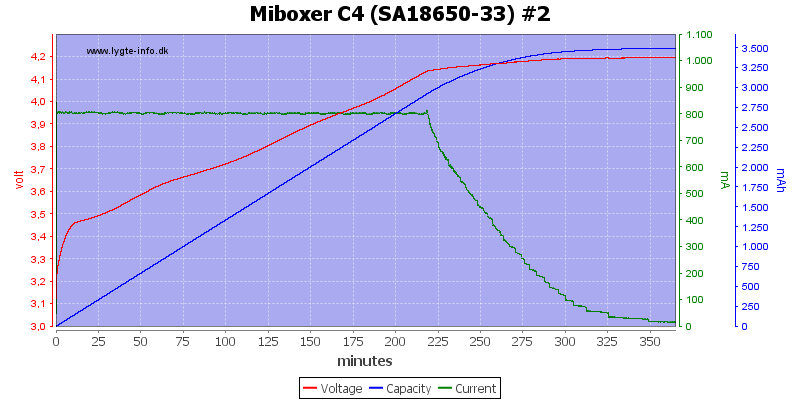
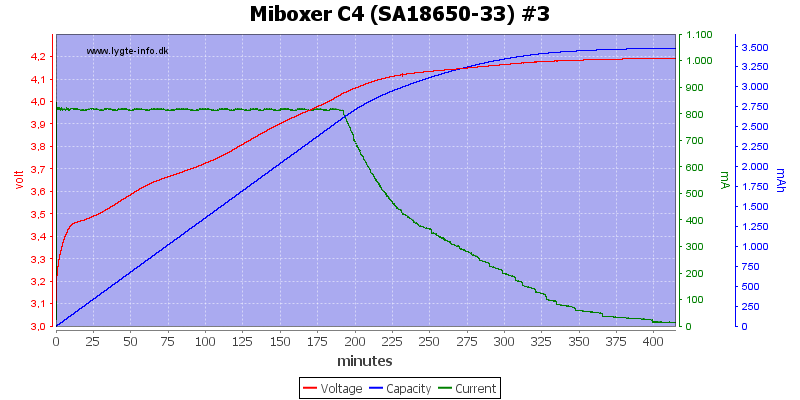
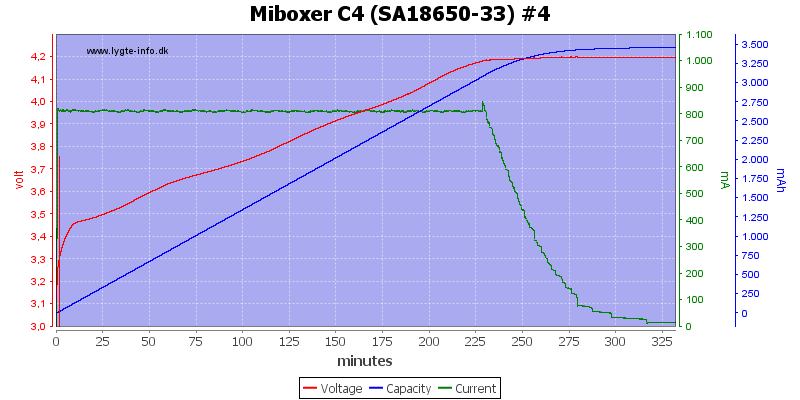
The other 3 channels looks similar.
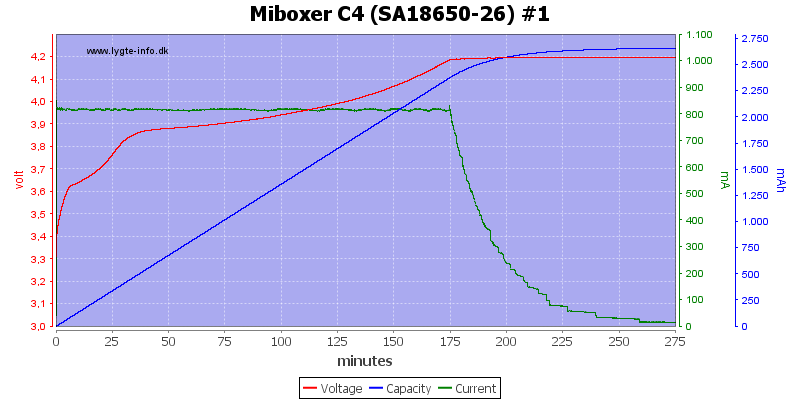
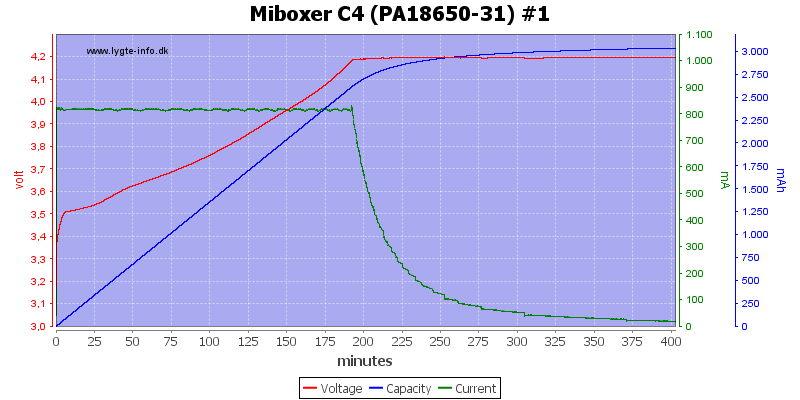
No problem with other capacities.

The old cell is also handled fine, except for the missing termination.
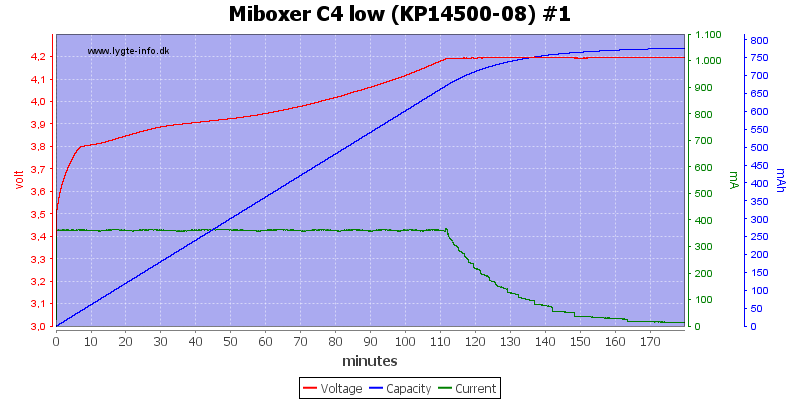

The low current is fine for smaller cells, but again the termination is missing.
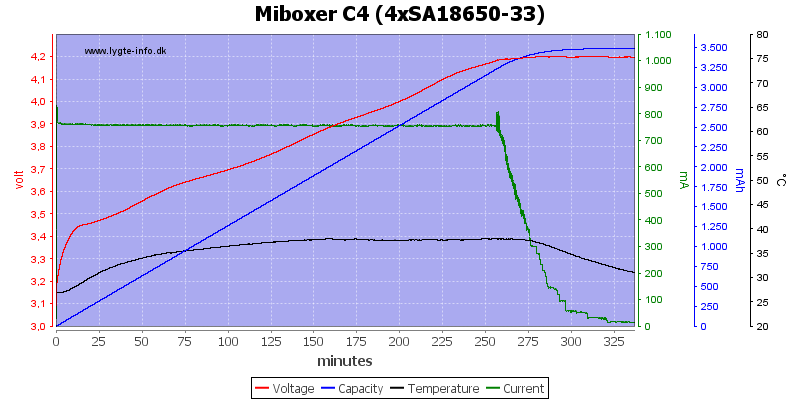
The current is also 800mA with four batteries in the charger.
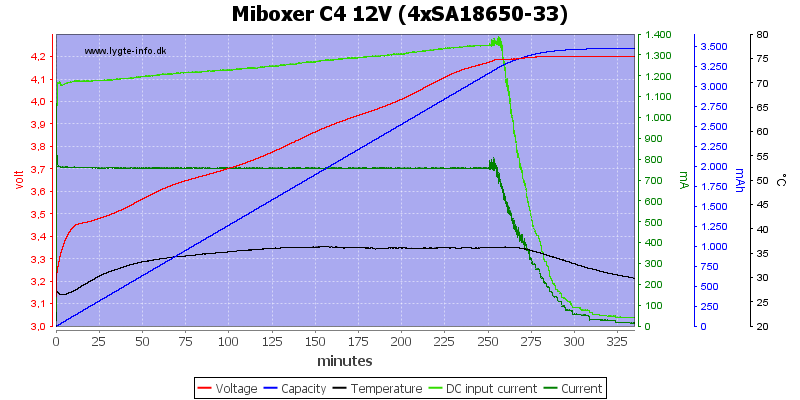
It requires up to 1.4A from 12V to charge four batteries..
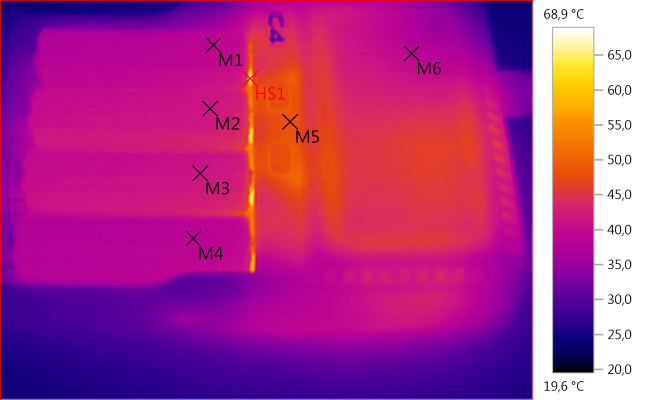
M1: 39,1°C, M2: 41,6°C, M3: 41,5°C, M4: 38,7°C, M5: 48,3°C, M6: 39,0°C, HS1: 68,9°C
There is something warm inside the charger (This is very common), but the batteries are acceptable.

M1: 37,2°C, M2: 39,7°C, M3: 39,7°C, M4: 37,4°C, M5: 45,2°C, HS1: 56,7°C
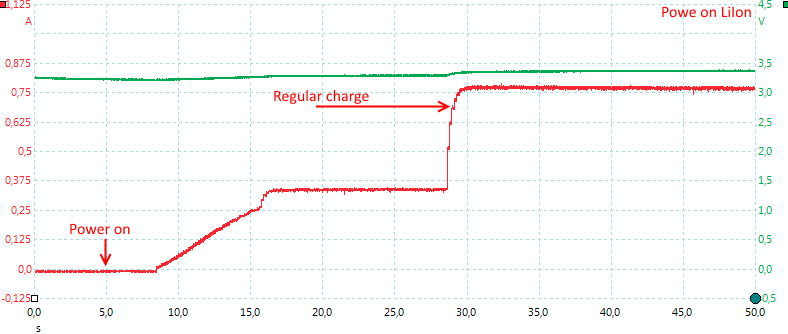
The charger starts up with low charge current and after some time changes to high charge current. This makes it possible to select low current before the charger switches to high current.
The total staring time is about 25 seconds.
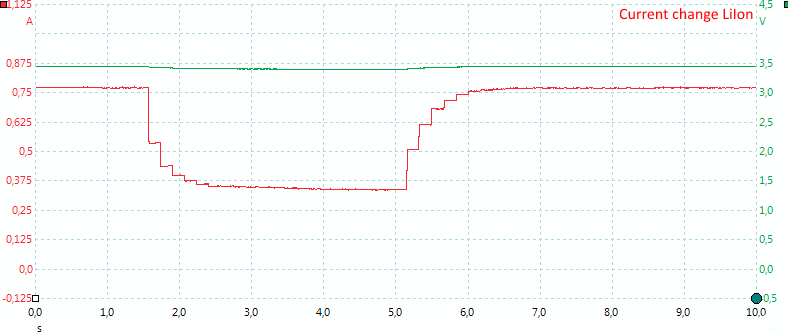
It is possible to change current at any time during the charge.
Testing 4.2V LiIon
The testing mode is only available on slot #4, i.e. only one battery can be tested at a time.
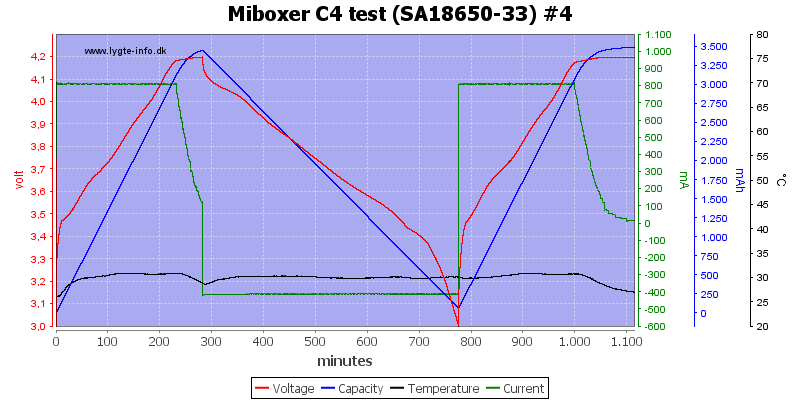
The charger will first charge, then discharge to 3V with 400mA and then charge again. When charging for test it has a termination at about 100mA
The display showed 3285mAh in capacity for the cell.
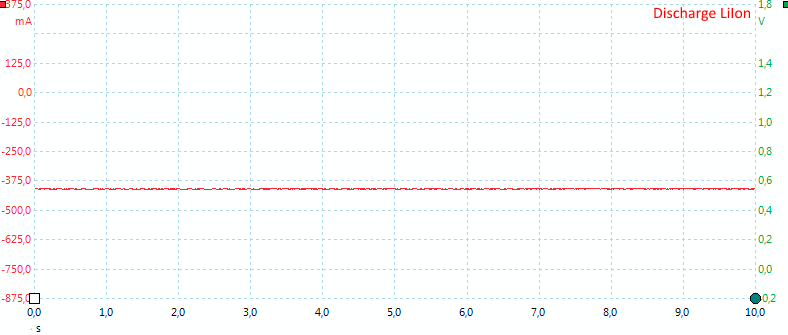
The discharge is done with constant current, no pwm.
Charging 4.35V LiIon

The 4.35V charge voltage looks fine, but again the termination is missing.
Charging 3.6V LiIon (LiFePO4)

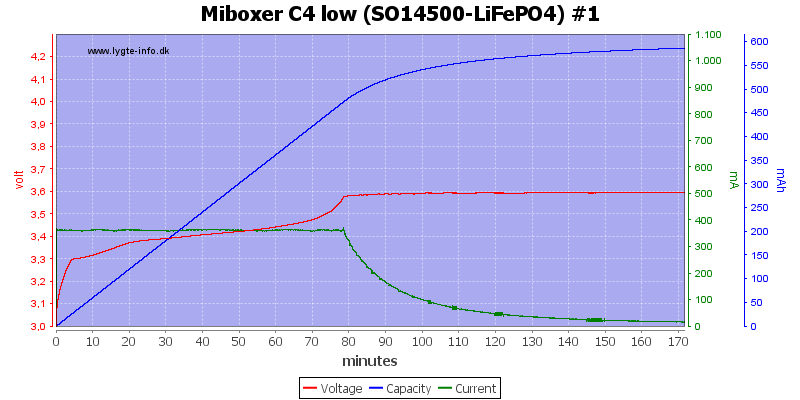
Both current settings charge to 3.6V on the LiFePO4 setting, but again the termination is missing.
Testing 3.6V LiIon (LiFePO4)

The charger will first charge, then discharge to 2.6V and then charge again.
Measuring Internal Resistance LiIon
Slot #4 will always measure internal resistance when a cell is put into it.
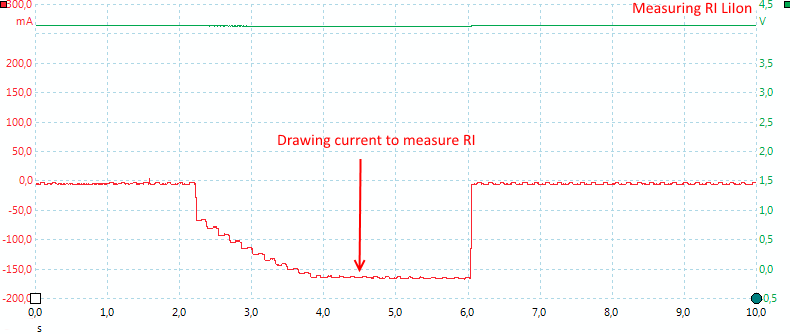
It works by drawing about 160mA for a few seconds and measuring the voltage drop.
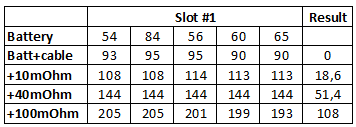
The results looks fairly good and the consistency is also fine.
Charging NiMH
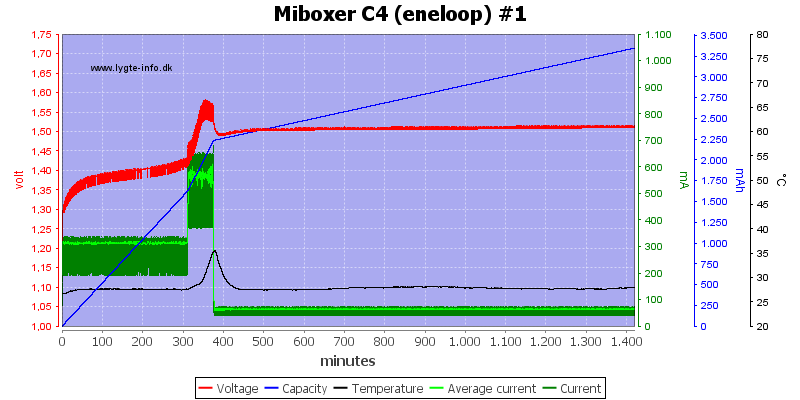
Charging NiMH is done at a fairly low current that prevents -dv/dt termination, the charger handles this by increasing the current when the battery is nearly full. With this increased current it can detect -dv/dt and terminates nicely.
When finished with the charging it will use a 60mA trickle charge, this is not good for LSD (low self discharge) cells.
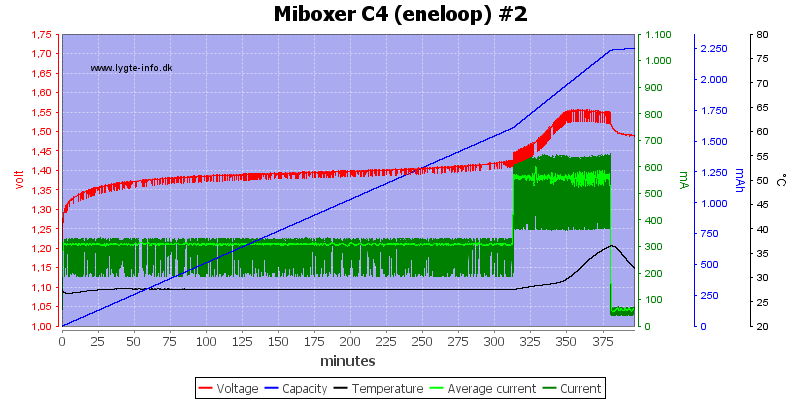
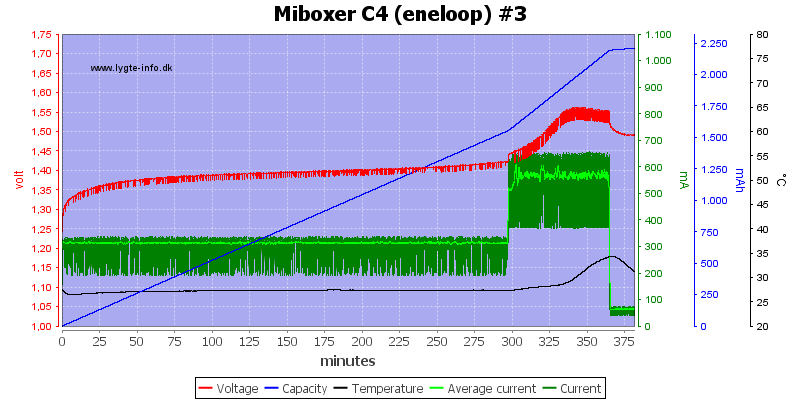
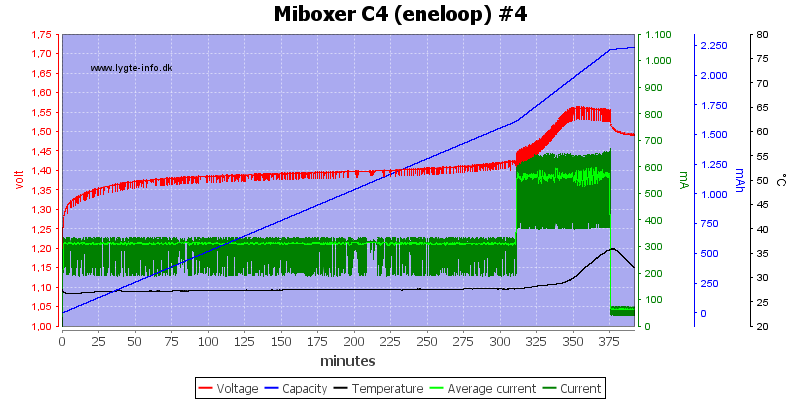
The other channels works the same way.
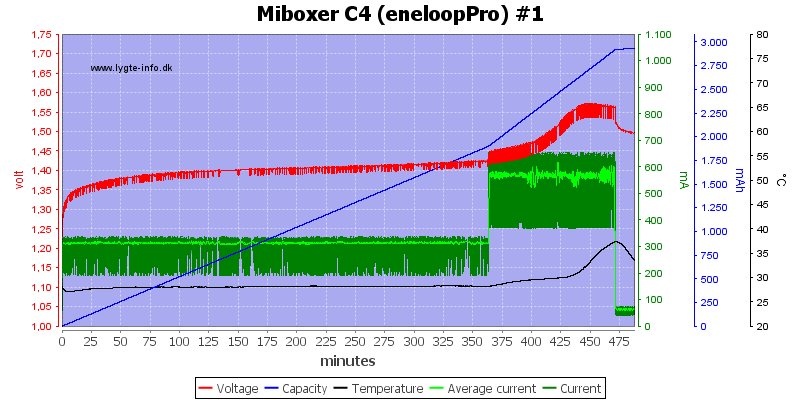
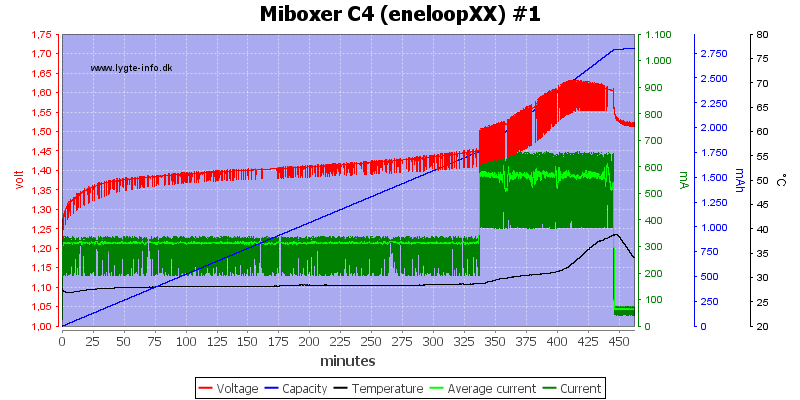
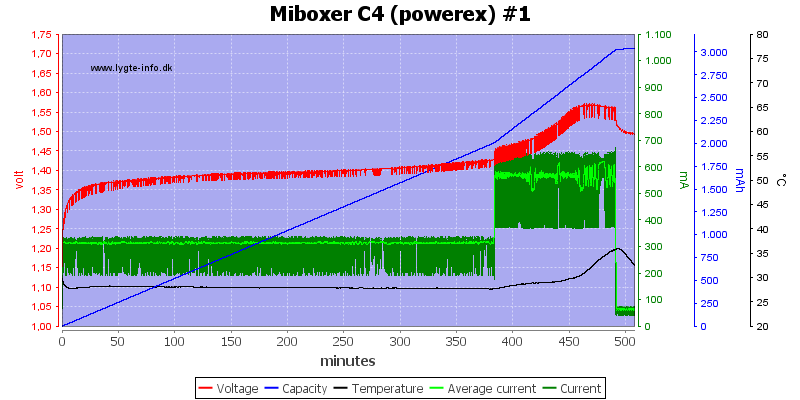
The 3 high capacity cells are also handled fine, even the old XX cell.
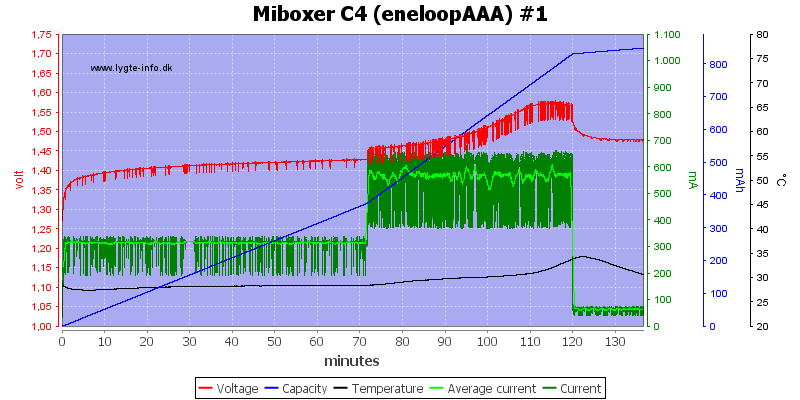
The AAA cell can be charged at the high current setting.
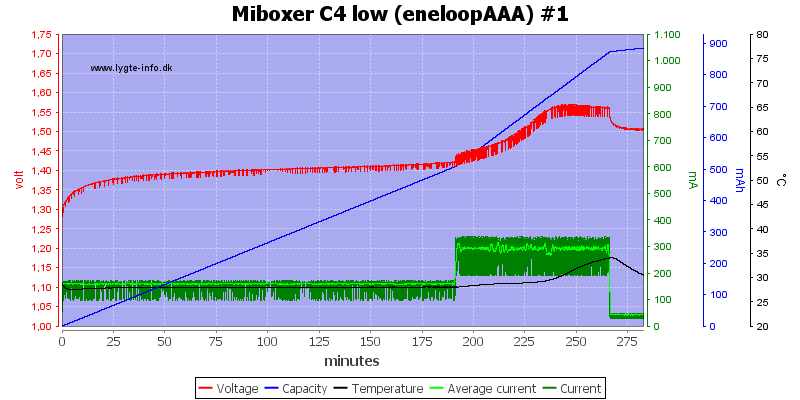
The low setting also works fine for AAA cells.
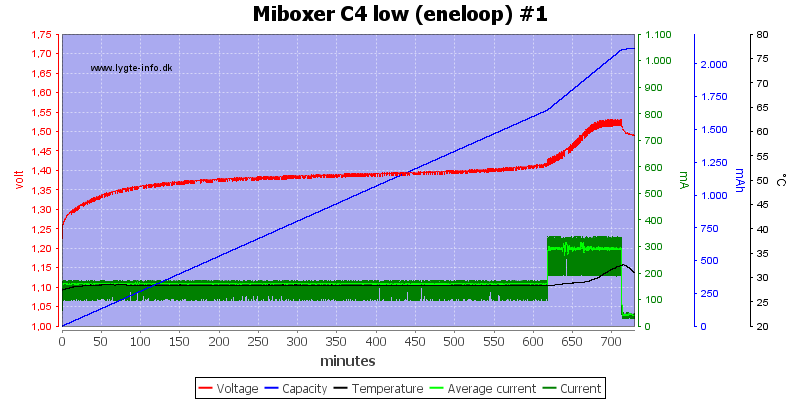
It can also handle a AA cell at low current, this is not done with -dv/dt, but maybe 0dv/dt.
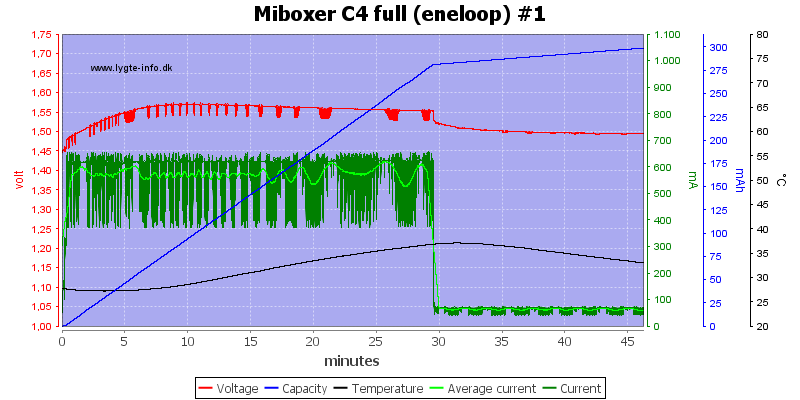
With -dv/dt detection it will take some time to detect a full battery.

The charger has no problem charging 4 NiMH cells at the same time
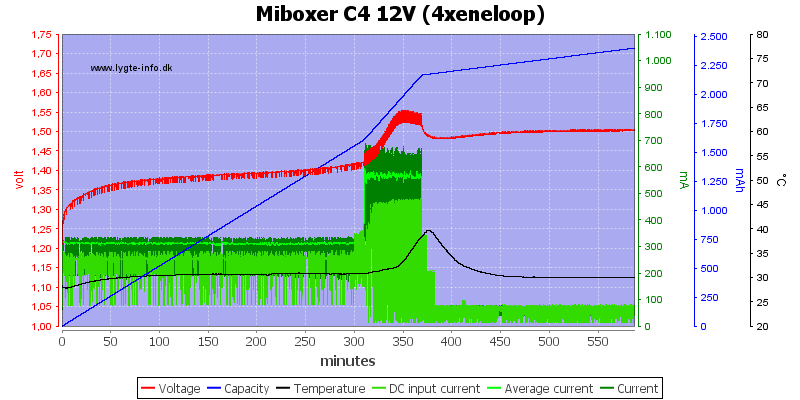
The low charger current means the charger has a fairly low current draw from 12V, the peak during termination is around 500mA
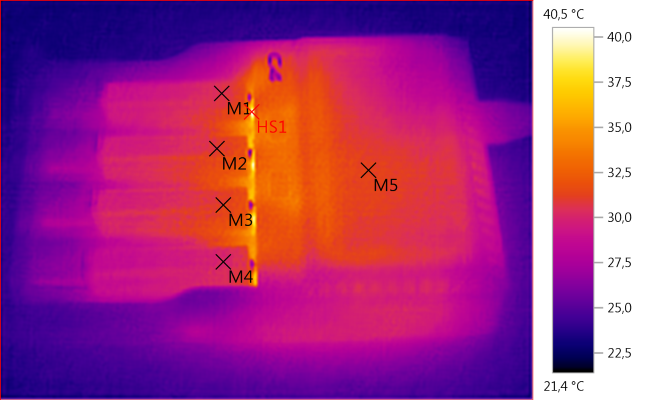
M1: 30,6°C, M2: 30,9°C, M3: 31,3°C, M4: 30,1°C, M5: 31,3°C, HS1: 40,5°C
The cells stays very cool during most of the charger (They do heat up during the final stage like all NiMH cells).
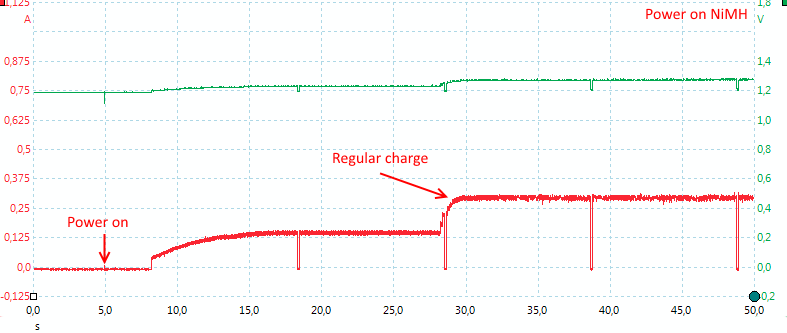
The charger starts up with low charge current and after some time change to high charge current. This makes it possible to select low current before the charger switches to high current.
The total staring time is about 25 seconds.
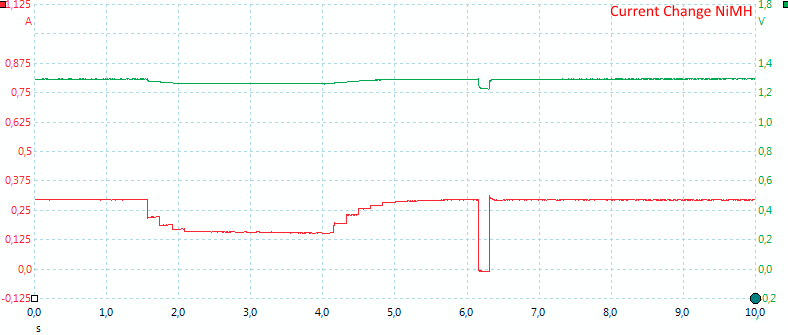
Current can be changed at any time. As is common with all NiMH chargers the current is turned off to measure the NiMH voltage.

During the final charging state the current is increased to 600mA.
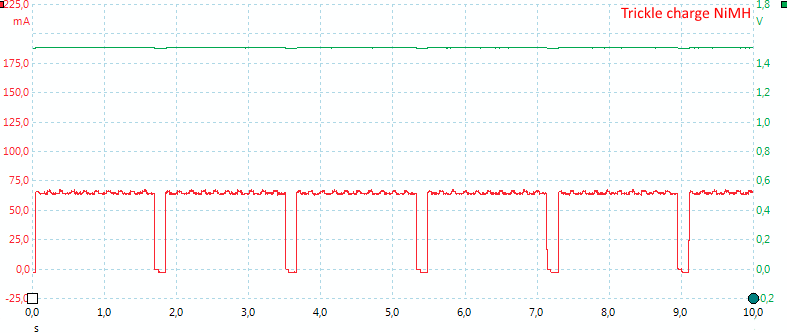
Trickle charger is about 60mA at high charge current (40mA at low). The current is constant, i.e. no pwm or pulsing.
Testing NiMH
The testing mode is only available on slot #4, i.e. only one battery can be tested at a time.
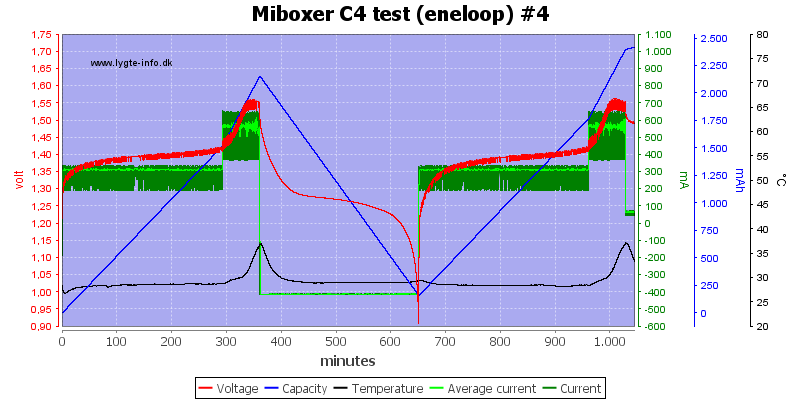
The charger will first charge, then discharge to 0.9V and then charge again. The charger do not use any top-off or trickle charge between the initial charge and the discharge.
The display showed 1932mAh in capacity for the cell.
Measuring Internal Resistance NiMH
Slot #4 will always measure internal resistance when a cell is put into it.
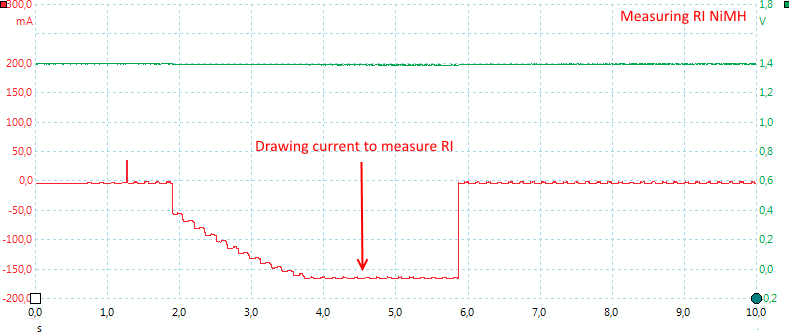
It works the same way as LiIon by drawing about 160mA for a few seconds and measuring the voltage drop.
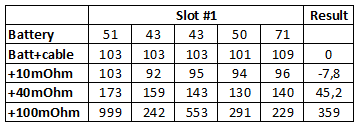
But I am not very impressed with the results for NiMH.
Testing with 2830 volt and 4242 volt between mains and low volt side, did not show any safety problems.
Conclusion
For a first charger there are many interesting functions on this charger: it can charger all the usual batteries and the NiMH termination works perfect, it has test function that can measure the internal resistance and capacity of batteries.
But there are some problems also:
- LiIon charger do never terminate, if batteries are removed when the charger say finished it is fine, but if the batteries are left in the charger it will wear them down.
- NiMH has a fairly high trickle charger, again no problem if the batteries are removed when the charger is finished, but will wear them down if they are left in the charger.
- The internal resistance function for NiMH looks rather unstable (LiIon looks fine).
- Only one slot has test functions. This is a question about convenience and time.
- The NiMH charger current is very low, it requires some patience on this charger.
Because the charger never terminates current I will only call it acceptable, except for NiMH non-lsd (low self discharge) batteries, where it is good.
Notes
The charger was supplied by a Miboxer for review.
Here is an explanation on how I did the above charge curves: How do I test a charger







































































